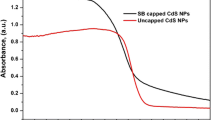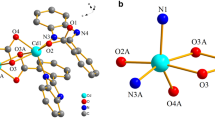Abstract
Both HA-CdS and HB-CdS (Hys-CdS, Hys represents HA, HB) complex systems were established according to the dynamics of heterogeneous electron-transfer process\(\mu = E_{S^* /S^ + } - E< 0\). In these systems, the electron transferring from1Hys* to conduction band of CdS is feasible. Determined from the fluorescence quenching, the apparent association constants (Kapp) between Hypocrellin A (HA), Hypocrellin B. (HB) and CdS sol. were about 940 (mol/L)−1, 934 (mol/L)−1, respectively. Fluorescence lifetime measurements gave the rate constant for the electron transfer process from1HA*,1HB* into conduction band of CdS semiconductor as 5.16 × 109 s−1, 5.10 × 109 s−1, respectively. TEMPO (2,2,6,6-tetramethy-1-piperdinyloxy), a stable nitroxide radical, was used in the kinetic study of the reduction reaction taking place on the surface of a CdS colloidal semiconductor, kinetics equation of the reaction was determined with the electron paramagnetic resonance (EPR) method, and the reaction order of TEMPO is zero. When Hys were added, the rate of EPR increased greatly. By comparing rate constants, the Hys-CdS systems were revealed to be about 350 times more efficient than CdS sol. alone in the photoreduction of TEMPO under visible light. It suggests that Hys can be used as efficient sensitizers of a colloidal semiconductor in the application of solar energy.
Similar content being viewed by others
References
Henglein, A., Small-particle research: physical-chemical properties of extremely small colloidal metal and semiconductor particles, Chem. Rev., 1989, 89: 1861–1873.
Serpone, N., Pelizzetti, E., eds., Photocatalysis-fundamentals and applications, New York: Wiley, 1989.
Kamat, P. V., Photoelectrochemistry in particulate systems. 9. Photosensitized reduction in a colloidal TiO2 system using anthracene-g-carboxylic acid as the sensitizer, J. Phys. Chem., 1989, 93: 859–864.
Usami, A., Theoretical study of charge transportation in dye-sensitized nanocrystalline TiO2 electrodes, Chemical Physics Letters, 1998, 292: 223–228.
Jiang Lijin, Structures, properties, photochemistry reactions and its mechanisms (I)—The structures and properties of hypocrellins, Chinese Science Bulletin, 1990, 35(21): 1608–1616.
Pivera, J. L., Gracia-jimenez, J. M., Silva Gonzalez, R. et al., Characterization of thin CdS films grown by the gradient recrystallization and growth technique, J. Appl. Phys., 1990, 68(3): 1375–1377.
Henglein, A., Mechanism of reactions on colloidal microelectrodes and size quantization effects, Topics in Current Chemistry, 1988, 143: 113–180.
Kamat, P. V., Chanvet, J. P., Fessenden, R. W., Photoelectrochemistry in particulate systems. 4. Photosensitization of a TiO2 semiconductor with a chlorophyll analogue, J. Phys. Chem., 1986, 90: 1389–1394.
Rossetti, R., Brus, L. E., Time-resolved Raman scattering study of adsorbed, semiosidized Eosin Y. formed by excited-stated electron transfer into colloidal TiO2 particles, J. Am. Chem. Soc., 1984, 106: 4336–4340.
Yang, J. J., Feng, L. B., Zhang, Z. J. et al., Study of photoreduction of MV2+ taking place on the surface of nanosized CdS particle, Photographic Science and Photochemistry (in Chinese), 1995, 13(3): 227–233.
He, H. Z., Jiang, X. F., Wang, D. Y., The photophysical characters of hypocrellin A in the capsule solution, Photographic Science and Photochemistry (in Chinese), 1992, 10(3): 193–199.
Diwu Zhenjun, William, L. J., Photosensitization by anticancer agents. 12. Perylene quinonoid pigments, a novel type of singlet oxygen sensitizer, J. Photochem Photobiol A: Chem., 1992, 64: 273–287.
Ira N. Leveine, Physics Chemistry, 2nd ed., New York: McGraw-Hill, 1983.
Wang Nenghui, Zhang, Z. Y., Relationship between photosensitizing activities and chemical structure of Hypocrellin A and B., J. Photochem. Photobiol. B: Biol., 1992, 14: 207–217.
Zhang, M. H., Weng, M., Chen, S. et al., Study of electron transfer interaction between hypocrellin and N,N-diethylaniline by UV-visible, fluorescence, electron spin resonance spectra and time-resolved transient absorption spectra, J. Photochem. Photobiol. A: Chem., 1996, 96: 57–63.
Xia, W. L., Zhang, M. H., Jiang, L. J. et al., Study of hypocrellin Aby nanosecond transient absorption spectra, Science in China (in Chinese), Ser. B, 1992, (3): 230–235.
Author information
Authors and Affiliations
Corresponding author
Rights and permissions
About this article
Cite this article
Zhou, Z., Liu, W., Wang, F. et al. Photo-induced electron transfer between hypocrellins and nano-sized semiconductor CdS. Sci. China Ser. C.-Life Sci. 44, 241–252 (2001). https://doi.org/10.1007/BF02879331
Received:
Issue Date:
DOI: https://doi.org/10.1007/BF02879331




